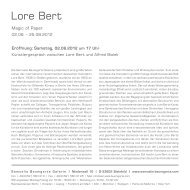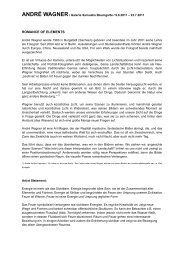Niki de Saint Phalle - Samuelis Baumgarte Galerie
Niki de Saint Phalle - Samuelis Baumgarte Galerie
Niki de Saint Phalle - Samuelis Baumgarte Galerie
You also want an ePaper? Increase the reach of your titles
YUMPU automatically turns print PDFs into web optimized ePapers that Google loves.
The connection to far-eastern i<strong>de</strong>as of wholeness can be seen reflected in the thicken-<br />
ing and thinning of the form, as Yin and Yang cannot grow at the same time. An in-<br />
crease in Yin is always matched by a <strong>de</strong>crease in Yang.<br />
<strong>Niki</strong> <strong>de</strong> <strong>Saint</strong> <strong>Phalle</strong> is known for her strong and strongly contrasting colours. She applies<br />
colours totally in the sense of the classic “local” colour, but practically in most<br />
cases even stricter than the Ancient Masters, as there is hardly any change of hue to<br />
be seen within a field of colour. Azure is azure everywhere, and so is pink. Exceptions<br />
to this rule can bee found in larger works, lessening the visual impact in favour of a<br />
unified appearance of the whole.<br />
Although she took, among other things, real and imagined animals for her motifs, such<br />
as cats (Kasimir, 1991) and dragons (Dragon, 1979), most of her work <strong>de</strong>als with the<br />
human figure. And again in the majority of works, the female figure. There is the occasional<br />
male, like the moustached pageboy type in the serigraph “My love what are you<br />
doing” (1969), but usually we encounter females.<br />
The gen<strong>de</strong>r of her figures is <strong>de</strong>termined by outline and shape, as the other features<br />
tend to be absent or very much reduced. What they do show, however – be they females,<br />
cats, dragons, snakes (Yin Yang, 1982), ostriches, or, in fact, architecture – is<br />
a somewhat overall <strong>de</strong>coration <strong>de</strong>ploying brightly coloured patterns: Dots and spots,<br />
stripes and (often concentric) circles, squares and oblongs, hearts and flowers (Nana<br />
with Yellow Dress, 1985), and stars and free irregulars.<br />
This brightly coloured <strong>de</strong>coration is <strong>de</strong>finitely not “on” the figures, in fact one has to<br />
see the Nanas and other beings as having this pattern as their “skin colour”. The colour<br />
scheme is not in<strong>de</strong>pen<strong>de</strong>nt of the form or vice versa, which is un<strong>de</strong>rlined by the<br />
fact that the natural colour of artificial resin (polyester), which <strong>Saint</strong> <strong>Phalle</strong> mostly used,<br />
is, so to say, no colour at all, much in contrast to, say, bronze. This is also transferred<br />
to her drawings, etchings, and serigraphs. What we see in them are not any brightly<br />
painted figures, rather we see figures with a brightly coloured skin.<br />
This, of course, is another instance of interpretation. The figures are <strong>de</strong>eply rooted in<br />
fantasy, but also refer to human customs of body <strong>de</strong>coration. When, for example, a<br />
member of an exotic tribe, like a “Huli Wigman” of Tari in the Southern Highlands<br />
11






